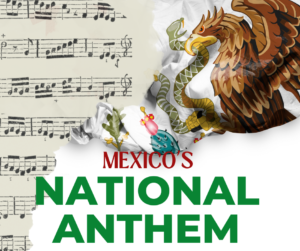Mexico, with its rich history and vibrant culture, boasts a national anthem that is both a source of pride and a symbol of unity. The Mexican National Anthem, or “Himno Nacional Mexicano,” is a powerful musical and lyrical composition that has played a pivotal role in the country’s history and continues to hold a special place in the hearts of its people.

A Brief History of the Mexican National Anthem
The origins of the Mexican National Anthem can be traced back to the early 19th century during Mexico’s struggle for independence from Spanish colonial rule. The need for a national anthem became apparent as the country sought to define its identity and assert its sovereignty.
In 1853, President Antonio Lopez de Santa Anna announced a national anthem competition, and the winning lyrics, written by Francisco González Bocanegra, were set to music composed by Jaime Nunó. This collaboration resulted in the creation of the anthem we know today.
The Lyrics: Poetry and Patriotism
The lyrics of the Mexican National Anthem are a testament to the patriotism and love for the country that inspired its creation. González Bocanegra’s words beautifully capture the essence of Mexican history, culture, and spirit. From the opening lines that call upon Mexicans to lend their voices in unity to verses that celebrate the country’s natural beauty, the anthem’s lyrics are deeply moving.
One of the most poignant verses of the anthem pays tribute to Mexico’s heroes, reminding all Mexicans of the sacrifices made to secure their freedom. This verse, known as the “Antiphon of Heroes,” is often sung with great emotion during official ceremonies and events.
We have a video on our YouTube channel that details the lyrics of this song and what they mean in English.
The Musical Composition: Jaime Nunó’s Legacy
Jaime Nunó’s musical composition perfectly complements the anthem’s lyrical beauty. The melody is both stirring and solemn, evoking a sense of pride and reverence. It’s worth noting that Nunó was a Spanish composer who embraced Mexico as his second home, and his legacy lives on through the anthem.
The anthem’s composition reflects a rich blend of European and Mexican musical traditions, showcasing the country’s cultural diversity and the fusion of indigenous, Spanish, and African influences.
Symbolism in the Mexican National Anthem
Deeply rooted in Mexican history and culture, the Mexican National Anthem is rich with symbolism that reflects the nation’s complex heritage and aspirations. One of the most iconic symbols within the anthem is the “eagle and serpent,” drawn from ancient Aztec mythology. This imagery represents the Aztec legend of the founding of Tenochtitlan, the precursor to Mexico City, where an eagle perched on a cactus while devouring a serpent. This symbol signifies the union of indigenous and European influences in Mexico’s history and serves as a powerful reminder of the country’s pre-Columbian roots.
Another symbol that resonates throughout the anthem is the resounding call to “War, war, without truce!” This phrase encapsulates the indomitable spirit of the Mexican people. It doesn’t merely allude to armed conflict but symbolizes the ongoing struggle for justice, equality, and the defense of national sovereignty. It speaks to Mexico’s determination to face challenges head-on, never yielding in the pursuit of its ideals.
In every verse and note, the Mexican National Anthem weaves a tapestry of symbols that tell the story of a nation’s resilience, its reverence for its indigenous heritage, and its unwavering commitment to progress. These symbols are not just historical relics; they are living reminders of Mexico’s past, present, and future, embodying the spirit of a nation that continues to evolve while cherishing its cultural roots.
Historical Moments: The Anthem in Action
Throughout Mexican history, the Mexican National Anthem has played a central and stirring role in numerous pivotal moments, becoming the musical backdrop to the nation’s triumphs and challenges.
One of the earliest and most significant performances of the anthem occurred in 1854, just a year after its composition. Since then, it has been sung during pivotal moments, symbolizing the nation’s enduring struggle for freedom and justice. During the Mexican Revolution (1910-1920), the anthem resonated across battlefields, motivating revolutionaries and galvanizing the Mexican people in their quest for social and political change.
In times of peace, the anthem remains an essential part of Mexico’s cultural tapestry. Every year, on September 16th, Mexicans gather nationwide to celebrate their Independence Day. At the stroke of midnight, the anthem echoes through plazas and squares, as people join in unison to sing and reflect on their history. This annual event serves as a poignant reminder of the sacrifices made by their forebears to secure the nation’s independence.
Furthermore, the Mexican National Anthem has found its place in the international arena. It is played with great pride and solemnity at diplomatic ceremonies and official events, symbolizing Mexico’s presence on the global stage. The anthem’s evocative melody and poignant lyrics resonate far beyond Mexico’s borders, conveying a sense of identity and unity that transcends language barriers.
Today, the anthem continues to inspire Mexicans from all walks of life. Whether it’s sung at sporting events, cultural festivals, or academic assemblies, the anthem serves as a unifying force that reminds people of their shared heritage and their commitment to upholding the ideals that have defined Mexico for centuries. The video we used to showcase the National Anthem on our YouTube channel is a version sung at a boxing event.
In the Mexican National Anthem, each note and lyric holds the weight of history and the promise of the future, making it a cherished and enduring symbol of Mexican pride and resilience. It is a reminder that, through all the challenges and changes of the nation, the anthem remains an unwavering anthem of hope and unity for the Mexican people.
Conclusion
The Mexican National Anthem remains an enduring emblem of Mexico’s spirit and resilience, echoing through classrooms, stadiums, and the hearts of its people. As we explore its history and significance, we’ll uncover how this cherished anthem has bound together generations of Mexicans and continues to inspire patriotism and heritage in the vibrant tapestry of Mexico’s culture.
Resources on My Bilingual Life
You might check out this timeline of Mexico’s history. It will give a solid foundation of the major events in Mexico’s history.
Read more about Mexico’s Independence Day.
Here is a related video about the Mexican National Anthem on our YouTube Channel.





